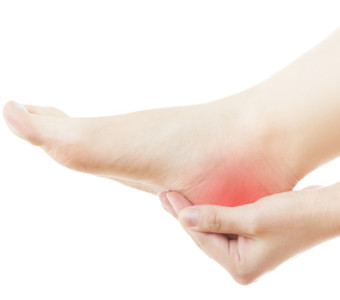 Haglund’s Deformity is categorized by a bony enlargement on the back of a person’s heel, and it’s often brought upon by our own doing. Today, we take a closer look at the condition and how it can be prevented and treated.
Haglund’s Deformity is categorized by a bony enlargement on the back of a person’s heel, and it’s often brought upon by our own doing. Today, we take a closer look at the condition and how it can be prevented and treated.
Causes and Symptoms of Haglund’s Deformity
Haglund’s Deformity develops when the bony enlargement on the back of the heel rubs against the back of your shoes. Pressure on the back of the heel irritates the soft tissue near the Achilles tendon, which can lead to bursitis and inflammation in the area. Haglund’s Deformity is often referred to as the “pump bump,” because it typically affects women who wear rigid-backed pump style shoes.
So while the condition is caused by pressure on the back of your heel, some people’s feet are pre-disposed to the condition, as those with high arches, a tight Achilles tendon or those who walk on the outside of their feet are more likely to develop Haglund’s Deformity. If you have those hereditary conditions and you wear a lot of solid-backed shoes, you’re putting yourself at risk for Haglund’s Deformity.
Symptoms of the condition include:
- An enlarged bony prominence on the back of your heel
- Blisters on your heel
- Redness
- Pain
- Swelling
Diagnosis and Treatment of Haglund’s Deformity
Diagnosis of the condition will occur with a clinical assessment and an X-ray to better visualize the structure and any damage. Once your doctor confirms the diagnosis, he or she will walk you through your non-surgical options. If you believe you may be suffering from Haglund’s Deformity, these non-operative techniques are good options to pursue when pain first sets in. Common non-operative treatments include:
Footwear modifications – Heel pads, heel lifts, custom orthotics or a softer-heeled shoe all help treat the condition by taking pressure off the heel.
Anti-Inflammatory Medications – As we mentioned, inflammation can set in when Haglund’s Deformity forms, so over-the-counter medications or anti-inflammatory creams can help control inflammation and pain.
Ice – Ice can help control swelling and inflammation. Consider icing the heel 2-3 times a day for 20 minutes at a time. Wrap the ice in a cloth before pressing against the skin.
Immobilization – If the area in extremely inflamed, immobilizing the foot in a soft cast or walking boot can allow healing to occur.
If conservative options don’t help stop the pain, surgery may be advised. A foot surgeon will make a small incision in your foot in order to surgically re-shape the heel bone. This procedure alleviates pressure on the heel bone, and post-op recovery will involve a combination of the non-operative treatment methods listed above.